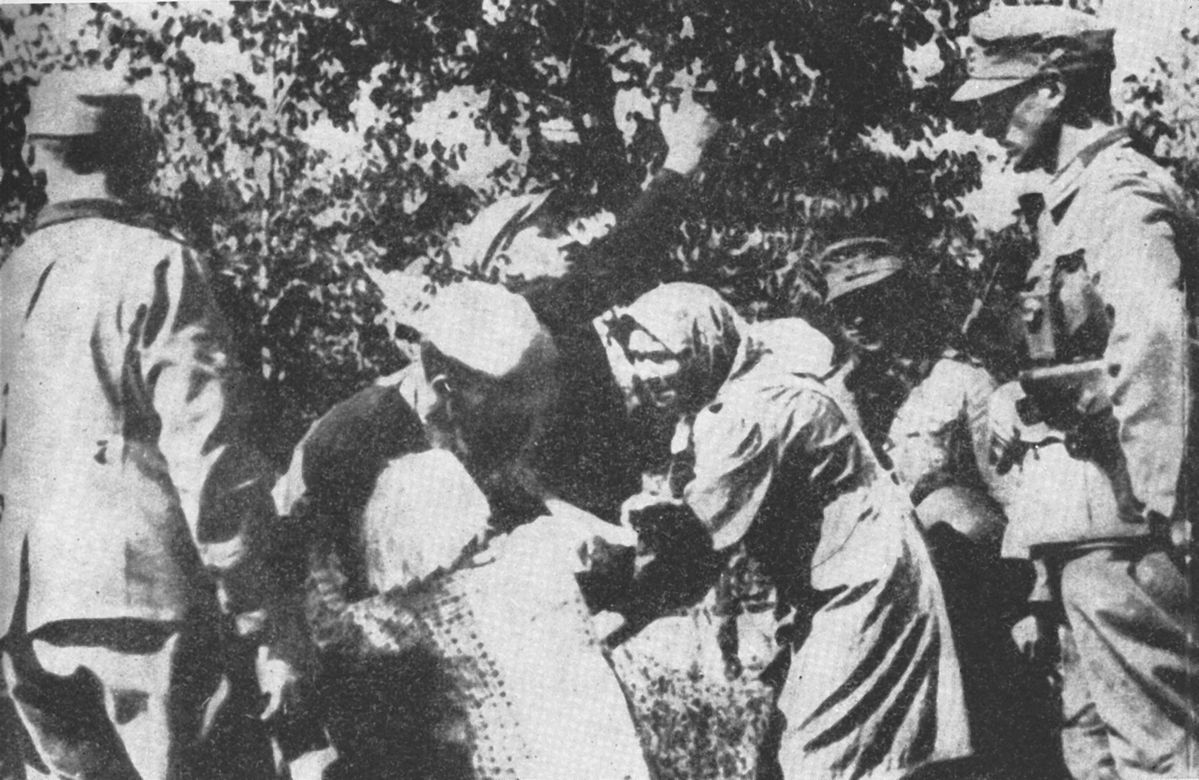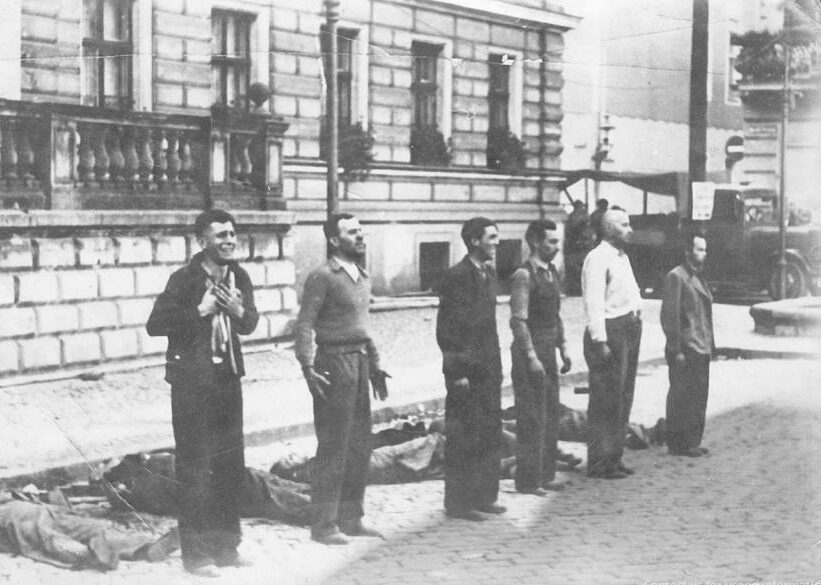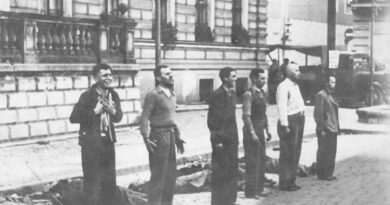The plan for Slavic extermination. The Germans started it in Poland

“The extermination plans were appalling. In the first phase of the GPO, the Germans wanted to kill about 100 million people” – says prof. Grzegorz Kucharczyk, a historian from the Polish Academy of Sciences and an expert in the history of the Third Reich
PIOTR WŁOCZYK: Why did the Zamojszczyzna region become a kind of prelude to the nightmarish German General Plan East?
PROF. GRZEGORZ KUCHARCZYK: The Germans carried out what can even be called the “pilot action” of the General Plan East (Generalplan Ost – GPO) in the Zamojszczyzna region. This was a huge German colonization campaign, which at the same time was to be one big genocide against the Slavs living in the eastern areas of Europe. The GPO was to be carried out after the final German victory in the war.
Zamojszczyzna was part of the Lublin District of the General Government. The head of the German terror apparatus there was Odilo Globocnik, the man responsible for the extermination of Polish citizens of Jewish origin in death camps such as Belzec and Sobibor. The Germans had a well-developed Holocaust machine in the nearby vicinity, which is why they chose Zamojszczyzna.
How large a scale of victims are we talking about in the context of the GPO?
The extermination plans were appalling. In the first phase of the GPO, the Germans wanted to kill about 100 million people. The Polish nation was to be reduced ultimately to a collective of several million people (after all, no longer a nation), who were to be used for slave labor. The rest of the Poles were to be murdered on the spot or deported beyond the Urals. A similar fate was to befall ethnic Russians, Belarusians, and Ukrainians. All those Slavs who inhabited the areas that were to become part of the German empire in Central and Eastern Europe were to be killed. This was the so-called Lebensraum that Adolf Hitler wrote about in “Mein Kampf.”
How did the SS specialists plan to murder so many millions of people?
In addition to murder in the extermination camps, the Germans also intended to exterminate tens of millions of people through devastating, torturous labor and starvation. Reading the analyses on this subject, written in cold language, is simply horrifying. The German empire was to be built on a foundation of genocide, after which a great settlement campaign was to begin. Slavs were to be replaced by “racially pure” Nordics.

At the same time, we must understand that the General Plan East was not a single document or decree by Hitler. It was a collection of documents, analyses and reports that were prepared in a special cell under the authority of the Reich Commissioner for the Strengthening of Germany in the East. Supervised by Heinrich Himmler, the commissariat was staffed by SS men with titles who planned the genocide in a “scientific” manner. The action in Zamojszczyzna was to show how this theory would work in practice.
Zamojszczyzna was attacked in this manner in November 1942. Why did it happen at a time when the German victory in the war was still very far off? Were the Germans impatient?
Here we are dealing with the logic of a leader state. One could see competition in the Third Reich for the position of the leader. Himmler was climbing to the top and wanted to show that he had achievements. The action in the Zamojszczyzna region was to be further proof of his effectiveness. Note that the Germans began mass murdering Poles in the Zamojszczyzna region in late 1942, i.e. at the apogee of the Holocaust in our lands. It was in that year that the bulk of Polish Jews were killed during Operation Reinhardt in Treblinka, Belzec, and Sobibor. That wasn’t enough for Himmler. He implemented another “project” to show that Hitler could count on him.
Who was the real “mastermind” of the German genocide against the Poles of Zamojszczyzna?
The SS men working in Himmler’s commissariat. These were the people with ambitions to present the genocide in a scientific light. Historians who study the subject are struck by the euphemisms the Germans used in the context of the GPO. It is known that for the genocide of the Jews, German functionaries referred to the “final solution of the Jewish question.” Meanwhile, when it came to the extermination of Poles, because that’s what the GPO boiled down to, they spoke of “changing the population structure” or “population rollback.” This verbal equilibrium was meant to conceal the real purpose, and on the other hand, in the intention of the German Holocaust planners, it was meant to add a kind of scientific twist to their work. The same effort was made to vaguely visualize racism or euthanasia.
How many Poles were to disappear from Zamojszczyzna?
The goal was clear: the entire Zamojszczyzna was to be “cleansed” and become a purely German area. Poles were thus to be confined to a kind of reserve. Indeed, the German settlement belt was to cut the Polish territory in half. Not only villages, but also towns and cities were to be taken over. Zamość, for example, became Himmlerstadt for a brief period.
On the one hand, there was ethnic cleansing in Zamojszczyzna, and on the other hand, we saw racial selection. The children of Zamojszczyzna are the most dramatic chapter of this genocidal project. In the German plans, the so-called “most racially valuable element” was to be preserved. Indeed, the purges were carried out not on the basis of nationality, but precisely on the basis of race. Thus, if a Polish child met the Nazi definition of Aryanness, he or she could be targeted for Germanization.
How did the Germans envision the Polish reaction? Did they assume that resistance would make it very difficult to carry out genocide and population exchange?
The Germans reckoned on resistance, but its scale certainly took them by surprise. Formations of the Polish underground united on this issue and took up arms against the implementation of German colonization plans. We should also remember that during the course of the action in the Zamojszczyzna region there was a solstice on the Eastern Front. In February 1943, the Germans lost at Stalingrad. Then, in the summer of 1943, they suffered a strategic defeat at the Battle of the Kursk Arc, which turned the tide of the war in the East. The Germans had increasing problems with their reserves since they had to bail out the collapsing front. Another thing is that in the genocidal machine in Zamojszczyzna itself, not everything worked as the planners in Berlin had imagined.
What specifically was failing?
The interaction between the SS, police, and auxiliary formations. This, by the way, can be seen in German reports. The commanders of the various formations themselves complained that cooperation with other units did not look as it should. Contrary to what we think of the German organization, “genocidal synergy” was not achieved at that time.
The unification of the underground in those areas is impressive. Virtually everyone, even the communist formations, worked in the same direction: to stop the genocide and obstruct the settlement action.

This was an absolutely fundamental issue, the survival of the nation was at stake, so everyone from left to right had to work together. In the face of the struggle for mere existence, political differences had to recede into the background here. Therefore, the Nationalists, the Home Army, the Peasant Battalions, but also precisely the communist formations were forced to act together for a time. I would point out, however, that the cooperation of various armed formations in the Zamojszczyzna region is not the only manifestation of solidarity among Poles. At that time, we had to deal with a huge mobilization of help from the civilian population, and not only from the Lublin area. It was a truly spectacular manifestation of solidarity.
How was it manifested?
The children of Zamojszczyzna were transported by the Germans on trains in inhumane conditions. Poles from Zamojszczyzna, but also from other parts of occupied Poland, tried to save these children. There is a famous scene in the TV series Polskie Drogi (“Polish Roads”) when Leon Kuraś buys a whole wagon of Polish children. This is not an invented scene. In fact, such events took place. Researchers of this topic point out that foreigners also joined in the rescue of the children. There is a well-known case of a Swedish aristocrat, who bought a wagon of Polish children from the Germans for a near fortune, thus saving their lives. Children who were not so lucky faced a tragic fate. The Germans even forbade giving them balls of snow during train stops so they could quench their thirst. Despite this, Poles helped as much as they could. It is difficult to overestimate in this context the role of Jan Tomasz Zamoyski, who through his channels intervened with the occupying German authorities, with no guarantee that he himself would not end up in a death camp because of this. At the time, we were dealing with a great Polish spurt of solidarity towards the German victims from the Zamojszczyzna region.
(…)
In total, more than 110,000 Poles were expelled from Zamojszczyzna. How many of them died?
Estimates vary widely here. The safest way is to say that tens of thousands of Poles were murdered by the Germans as a result of the colonization campaign in Zamojszczyzna. To date, we also do not know the exact scale of the victims among the children of Zamojszczyzna. And although it is hard to believe, we still do not have a modern museum in Poland that would tell the story of the tragedy of the Children of Zamość. A museum that would fully show what kind of kulturträgers the Germans really were, what kind of “culture” they offered in Poland at the time…
Prof. Grzegorz Kucharczyk is a historian, specializing in the history of political thought of the 19th and 20th centuries and the history of Germany. His latest book has just been published in Polish bookstores, III Rzesza Niemiecka. Nowoczesność i nienawiść (“The Third German Reich. Modernity and Hatred.”)
This article was published in June 2023 in “Do Rzeczy” magazine.




